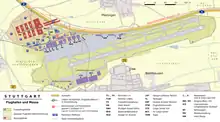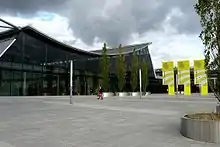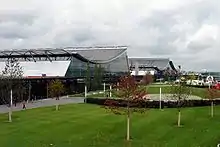Stuttgart Trade Fair
Messe Stuttgart is an exhibition and trade fair centre next to Stuttgart Airport, 7 miles south of Stuttgart, Germany. It is the ninth biggest trade fair in Germany.
 | |
| Type | German limited (GmbH) |
|---|---|
| Industry | Trade fairs and exhibitions |
| Founded | 1940 |
| Headquarters | Stuttgart, Germany |
Key people | Ulrich Kromer von Baerle |
| Products | Trade exhibitions |
| Revenue | € 61 million (2006) |
Number of employees | 237 (2006) |
| Website | www.messe-stuttgart.de |

.jpg.webp)


The new exhibition grounds, which were completed in 2007, are right next to the A8 autobahn (motorway). The centre is accessible from Stuttgart Flughafen/Messe station on the local suburban railway network. Buses also travel to the trade fair centre from nearby Esslingen, Göppingen, Reutlingen and Tübingen. As part of the Stuttgart 21 Project, there are plans to link the trade fair centre and airport to the proposed Stuttgart–Wendlingen high-speed railway between Stuttgart and Ulm by 2019.
Car park

One of the most striking features of Stuttgart Messe is its huge car park which spans the A8 Autobahn. The car park has space for 4200 vehicles on five stories. Display rights for the 4 ton logo on both sides of the car park bridge were sold to Robert Bosch GmbH who paid around 20 million euros for exclusive advertising space. The logo is the second largest illuminated sign in the world and the biggest logo in the world after the unlit Hollywood Sign.[1]
Brief history
Before completion of the new site next to Stuttgart Airport, Stuttgart Messe was based for more than 50 years in the Killesberg suburb of Stuttgart. As nearby housing estates encroached on trade fair parking and roads, the old fair was closed down to make way for social housing for old aged pensioners and apartments.
Criticism
Immediately after opening, Stuttgart Messe was plagued by a number of unexpected teething problems, ranging from faulty barcode readers at the entrances to poor signage.
Construction of the new site, which was originally approved in 1993, was subject to frequent delay. First of all, local farmers refused to sell their land after successful lobbying by nearby residents. After compulsory repossession of land was approved by the Baden-Württemberg State Government, demonstrations came to a peak resulting in a string of court cases between landowners and the company commissioned to build the new trade fair centre. Eventually agreement was reached between the local government and landowners, amid cries from local residents that the farmers had "sold out" to the politicians and had only gone along with lobbyists in the first place to maximise returns on the sale of land.
References
- (German) 'Bosch will ins Guinnessbuch der Rekorde.' (Bosch wants to make it into the Guinness Book of Records), Stuttgarter Zeitung Newspaper, 24 September 2007